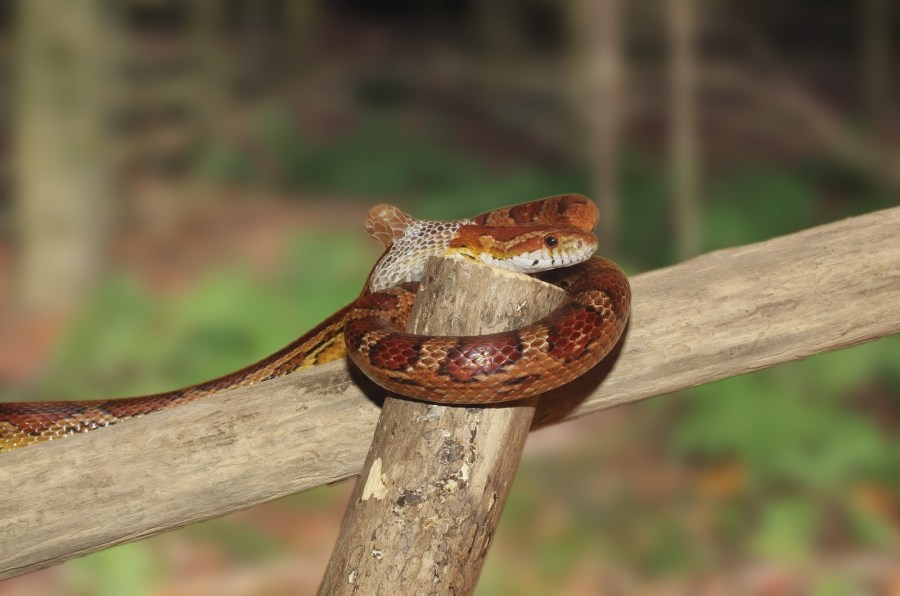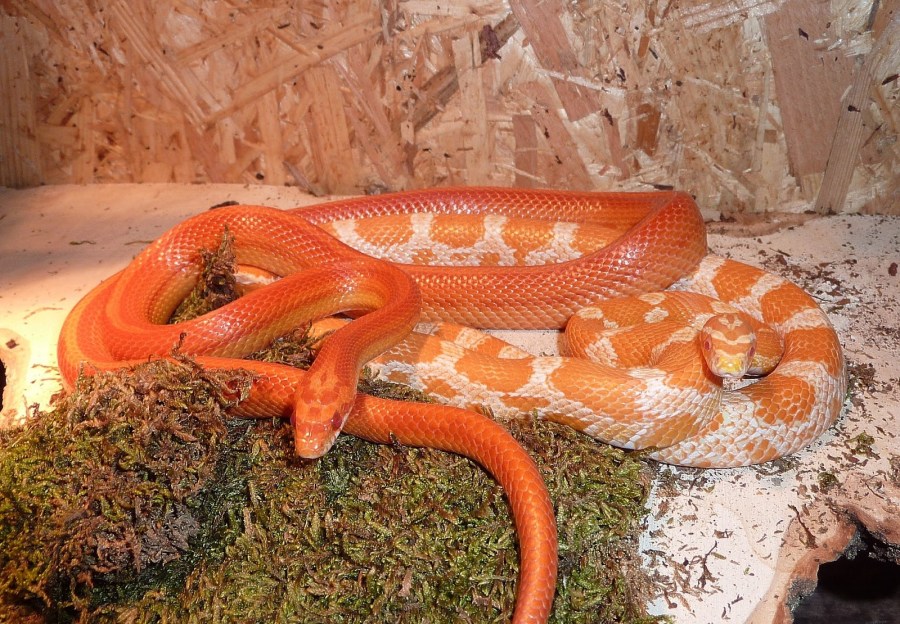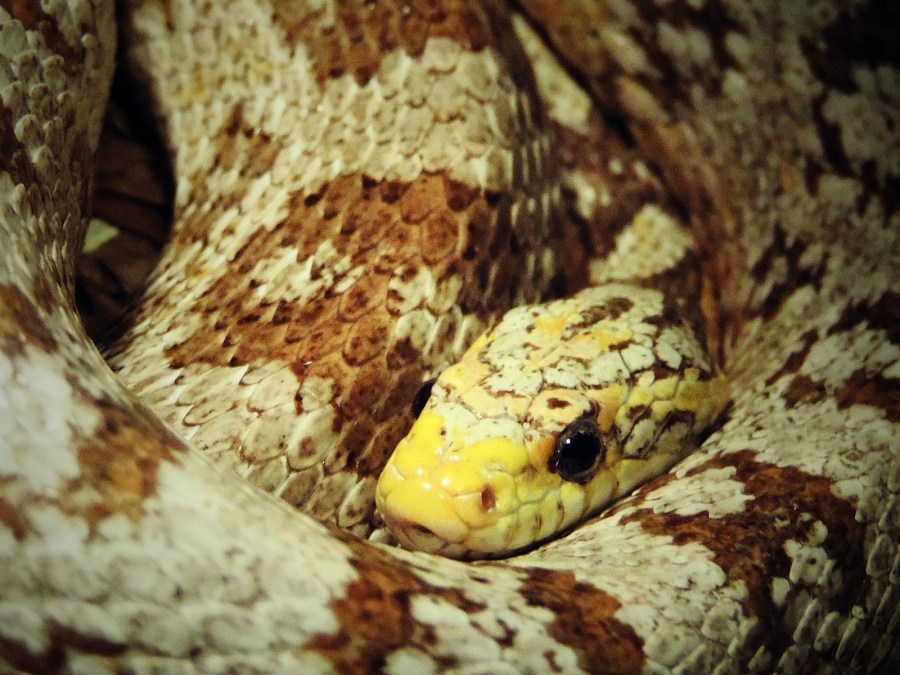Where to Find Lizards to Feeding Corn Snake
There's so much to learn about corn snakes and plenty to know about their different morphs and colors. Snakes are amazing creatures, and as soon as you begin to learn more regarding their different morphs, you'll see why for yourself.
Today, we're going to discuss 50 stunning corn snake morphs. By the time you're done reading, you're going to have a robust understanding of these unique, intelligent creatures.
We'll begin by sharing some background information on corn snakes themselves, and then we'll share some of the most stunning corn snake morphs and colors you will find. Get ready–because your mind is going to be blown!
What Are Corn Snakes?

Image Attribution: Sipa
Did you know that the corn snake was named for the pattern that they have on their belly? It's true! These stunning creatures have a pattern on the scales on their stomach that appear to be similar to maize. Maize is an ancestor of the food that we consume nowadays called corn.
Corn snakes are known for several things. For one, they're known to be escape artists, so keep an eye on yours if you have one. In addition, they're excellent climbers, which makes them even better at making a quick getaway.
The average adult corn snake will be somewhere between four to six feet long. They can live to be up to 20 years old–if you're caring for them correctly. They also follow a carnivorous diet, so be sure that you're feeding them correctly so that they stay nourished and healthy.
Your corn snake will reach their full adult size within two to three years, as long as you provide them with the proper food to help them do so.
Corn Snakes' Diet
A corn snake requires a well-balanced diet. For these animals, that means rodents that are appropriately sized. They must be thawed and warmed to above room temperature so that your pet snake will be able to consume them properly.
In addition, we want to stress the importance of never using a microwave to defrost frozen rodents, and you should also never prepare them in the same area that you prepare food for human consumption. If unavoidable, thorough disinfection is entirely necessary.
Finally, if you choose to feed your snake a diet of live rodents, you should never leave them unattended while you do so. This is because these live rodents can harm your snake, sometimes to a fatal degree.
When you're feeding your pet corn snake, you should feed them once a week when they're a juvenile and once every one to two weeks into their adulthood. Be sure to feed your pet in a separate tank. This will ensure your snake doesn't associate your hand or their home being ajar with feeding time.
You might be wondering about your snake shedding their skin. When it's time, their eyes will become a milky blue or grey over the course of several days. Their body, by contrast, begins to dull in color, and a whitish sheen is developed. They can even become irritable, so avoid handling them if you can.
The snake does regularly shed their skin, which is why you need to ensure that their habitat has the proper humidity levels so they can shed it correctly. In addition, you should never try to remove any eye caps you might find on your own; instead, seek veterinary care.
Home Sweet Home Care
Finally, we want to share the importance of properly maintaining your corn snake's home. You should clean and disinfect their habitat at least once a week. To do this, put your snake in a secure place, scrub the tank and furnishings using a 3% bleach solution, and rinse using water.
Finally, you should remove all traces of the bleach smell, dry the tank and furnishings, and put clean substrate into the habitat.
As for the habitat itself, be sure that you have an appropriately sized space for your animal. They do get larger as they grow, so you might need to upgrade if you start with a space that's tiny.
In addition, be sure you select the right substrate for their habitat. You can choose from aspen shavings, mulch-type substrates, including coconut fiber bedding or a reptile bark, or even a specific type of dampened moss.
Be sure you give your corn snake somewhere to hide, and the humidity is at the correct percentage. It should be 40 to 60%, but that number increases during shedding. Finally, be mindful of the temperature and lighting.
10 Popular Stunning Corn Snake Morphs & Colors

Image Attribution: Pexels
Now we want to share some stunning corn snake morphs and colors that you might find. There is plenty of variation for corn snakes, which means that there are a wide variety of different morphs and colors.
Here are some beautiful ones:
#1: Anerythristic-Anery
These corn snakes are considered to be the opposite of the amelanistic corn snakes. This is because instead of lacking black pigment, they lack red pigment.
They're usually various shades of grey, brown, black, and white. It can be difficult to find one of these, but we're sure with a bit of searching you can find one at a reasonable price.
#2: Aztec
With their wild, broken zig-zag pattern seen in scattered patches, these corn snakes have a highly dramatic appearance. Breeders are currently infatuated with breeding snakes with the Aztec morphs.
#3: Palmetto
This type of corn snake is one of the most widely renowned, popular iterations. They are usually mostly white except for a few random patches. This is because of a gene that the snake might have.
#4: Tessera
This pattern is actually the first known dominant mutation in corn snakes. As a result, the snake might have a thin, dark-edged dorsal stripe. This squares and pushes the pattern down the snake's sides. It has plenty of color mutations.
They're usually pretty reasonably priced.
#5: Calico
A calico corn snake has catered white patches and freckles that are shown as the snake grows up. Breeders have stopped focusing on the mutation due to the fact it's hard to identify in hatchlings, and raising the babies is costly. Additionally, there is "unattractive" blistering that appears under the white areas that develop.
#6: Caramel
This type of corn snake features neutral shades–usually in brown, gold, black, or yellow. These aren't especially common, and they are known for their sweet appearance. This is caused due to their neutral shades instead of bold reds and oranges.
#7: Charcoal
This type of corn snake appears to be very similar to the anerythristic corn snake. Still, it actually has a genetically separate gene mutation. These snakes are also sometimes known as the Pine Island Black Albinos.
They can be a bit harder to find, but with some searching, it's possible.
#8: Cinder
Take a look at the cinder corn snake, and then look at the anerythristic and charcoal ones. They look similar when they hatch, but over time as they mature, you will find that the cinder develops red undertones in their markings, too.
They are also known for their slightly more slender body makeup. They're definitely more costly than the typical genetic variations and usually will cost you about $85 or more.
#9: Diffused
Next, we have the diffused pattern snake morph. This takes away the belly checkers and the saddle-like pattern that's on the back of a corn snake. These animals often look odd as hatchlings, but their patterns fade as they reach adulthood.
The result? A red or orange corn snake with a solid white stomach.
#10: Dilute mutation corn snakes
Corn Snakes with dilute genetics might have significant fading of the snake's colors. For that reason, they might appear to be always shedding. This is a newer genetic mutation seen in corn snakes, and they don't usually cost more than the regular corn snake would.
This gene usually is paired with another genetic mutation, so keep an eye out for which one your snake might have.
40 Other Stunning Corn Snake Morphs & Colors

Image Attribution: chrisbrownie
Those are just ten popular and stunning corn snake morphs and colors. There are others, however, and we also want to share those with you today.
Of course, all corn snakes are beautiful in their own unique way. While their morphs can be one reason why you choose one corn snake over another, we'd really encourage you to choose your snake based on their unique personality instead of basing your decision on their appearance.
- Hypomelanistic
- Lava
- Chestnut
- Lavender
- Red Coat
- Motley
- Microscale
- Strawberry
- Scaleless
- Sunkissed
- Striped
- Terrazzo
- Sunrise
- Ultra
- Toffee
- Masque
- Okeetee
- Ghost
- Black
- Snow
- Eastern
- Opal
- Blood Red
- Florida
- Candy Cane
- Fancy
- Creamsicle
- Normal
- Coral Snow
- Butter
- Texas
- Reverse Okeetee
- Jungle
- Pewter
- Crimson
- Blood Red Pied-Sided
- Blizzard
- Miami Phase
- Blue
- Pink
Super Snakes
No matter what color morph or mutation you choose, we know that you will love your corn snake. These animals can make wonderful pets–just be sure you do your research before you commit to adding one to your family!
There's so much to learn about corn snakes, and we hope that we've got you started on the right foot by sharing everything we know about corn snakes' stunning morphs and colors.
SOURCES:
Top 40 Corn Snake Morphs, Color Chart & Pictures | Everything Reptiles
30+ Beautiful Corn Snake Morphs & Colors (With Pictures) | Reptile Guide
Maize | Science Direct
Snake Shedding 101 – Why Snakes Shed Their Skin | Reptile Knowledge
Source: https://www.reference.com/pets-animals/corn-snake-morphs?utm_content=params%3Ao%3D740005%26ad%3DdirN%26qo%3DserpIndex&ueid=34a1b050-5c22-4053-84d4-d9ba820390c7
Belum ada Komentar untuk "Where to Find Lizards to Feeding Corn Snake"
Posting Komentar